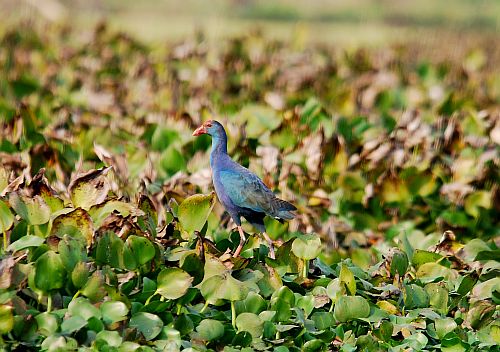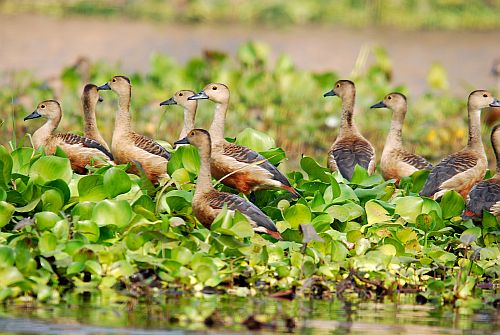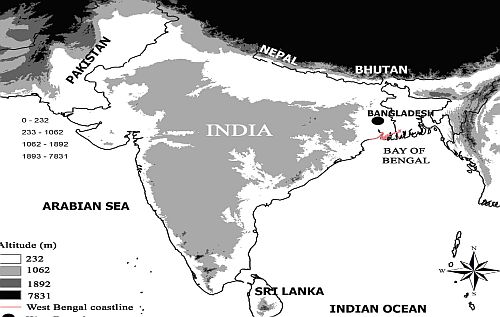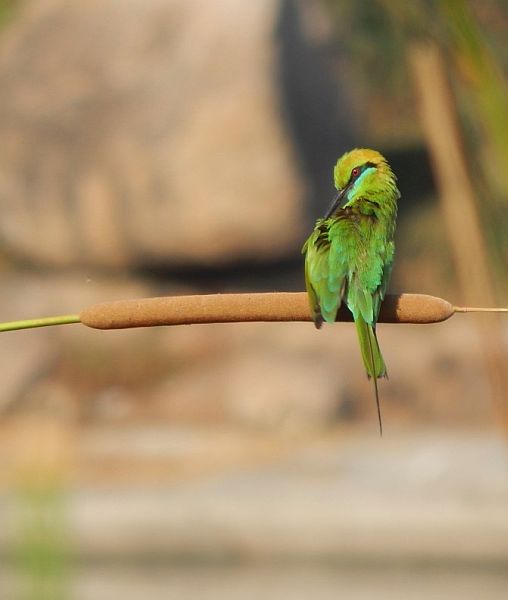The North Eastern (NE) region of the India is a biodiversity hotspot and represents one of the highest avian biodiversity of the Indian subcontinent. The region is ecologically represented by the Eastern Himalayan biome and is rich in a number of endemic flora and fauna. Several avian species inhabiting this unique ecosystem are not found or reported anywhere else in the world. The region is represented by seven Indian states, namely: Assam, Arunachal Pradesh, Manipur, Meghalaya, Mizoram, Nagaland and Tripura. Often these seven NE states are referred to as the Seven Sisters. The region has international boundaries with Bhutan, China, Myanmar and Bangladesh. The Himalayan state of Sikkim and the Darjeeling district and northern reaches of the Cooch Behar and Jalpaiguri districts of the eastern Indian state of West Bengal are ecologically contiguous with this region and together they represent an unique region with unparallel natural beauty, amazing ethnic diversity and a spectacular biodiversity of birds.
The NE India constitutes vast evergreen forests of the Brahmaputra river valley, the broad leaf forests at the foothills and the high altitude sub-alpine coniferous vegetation and the Indo-Myanmar dense bamboo and pine forests. This is a vast ecosystem include the elements of riparian as well as low and high altitude mountainous ecosystems suitable as premier bird habitats. This region hosts one of the most famous and celebrated sanctuaries and reserved forests of the subcontinent as well as the world, known for their spectacular avian biodiversity: Dibang, Namdhapa, Eaglenest, Kamlang & Mehao (Arunachal Pradesh); Manas, Kaziranga, Garampani, Nameri, Dipor Bil, Pobitora, Pabha, Laokhowa, Bornadi & Oran (Assam); Bhagmara, Siju & Nongkhyllem (Meghalaya); Fakim, Intanki & Pulebatze (Nagaland); Keibul Lam Jao (Manipur); Ngengpui & Khawnglung (Mizoram), Gumti, Charilam & Sepaijhola (Tripura), Kyongnosla, Pangolakha, Meanam & Shingba (Sikkim) and Jaldapara, Gorumara, Singalila & Senchal (West Bengal).
The avifauna diversity of this region is spectacular and home to the Great Indian Hornbill (Buceros bicornis L) that has been placed under Near Threatened (NT) status by the IUCN. Several rare species of both resident and migratory birds are reported from this pristine habitat. Being located within the biome of the majestic Eastern Himalayas, the eco-region provides a unique habitat for a wide diversity of local species. This is not only an important ecosystem for the local and resident avian species; but also a diverse habitat for numerous short and long distance migrant species that crisscross the region during their annual and semi-annual migration. The unique ecosystem provides multiple species with adequate opportunity to feed and forage as well as nest, breed and raise their chicks successfully with relatively little anthropogenic pressures and carbon foot prints.
![]()
Fig 1. Diversity of avian species from NE India
Several avian species come and visit the NE from other parts of the subcontinent such as Central and Western Himalayas and southern India; and there are also species visiting the regions from the distant Siberia (Russia), Mongolia, central, southern and SE China, Myanmar Thailand, Indo-Chine, Pakistan, Afghanistan, Iran and Central Asian countries like the Tajikistan, Uzbekistan, Azerbaijan, Kyrgyzstan, Turkmenistan and Kazakhstan and west Asia. The avian diversity of the region include different species of ducks, swans, geese, teals, grebes, pochards, pintails, ibis, shanks, terns, pelicans, storks, Asian open bills, bitterns, spoonbills, sandpipers, plovers, cranes, egrets, herons, cormorants, kingfishers, lesser adjutants, greater adjutants, crakes, water hens, coots, moorhens, snipes, swamp hens, jacanas, rails, falconets, kestrels, hobbys, hawks, kites, vultures, harriers, goshawks, falcons, owls, owlets, eagles, ospreys, woodpeckers, pheasants, weaver birds, tailor birds, rollers, honey guides, hornbills, sunbirds, bee eaters, orioles, sand grouses, frogmouths, lapwings, muniyas, parakeets, quails, hoopoe, crow pheasants, yuhina, parrot bill, martins, warblers, tree creepers, babbler, pipits, wagtails, leafbirds, flowpeckers, sunbirds, grosbeaks, bantings, larks, thrushes, flycatchers, blackbirds, drongos, treepies, sparrows, common crow, jungle crow, mynas, starlings, barbets, bulbuls, nightjars, swifts, swiftlets, swallows, magpies, fintails, shrikes, wood shrikes, pigeons and doves, blue peafowls, piculets, robins, wild pheasants, swamp francolins, Bengal floricans, coucals, cuckoos, minivets, pitas, dollar bird, malkohas, curlews, ruffs, stints, cuckooshrikes, godwits and different finches to name only a handful.
![]()
Fig 2. NE India, a biodiversity rich eco-zone with numerous bird species
However, due to the remote nature of this region, economic development in this zone has been much slower compared to the rest of India. This eco-zone has been traditionally under developed; relying mostly on the vast forest resources, traditional agriculture and tourism as major industry. This actually left the local ecosystem and the environment undisturbed for several decades post independence with a unique habitat completely preserved and globally recognized as an important biodiversity hotspot center. However, the changing population dynamics of the region together with need for economic opportunities for the resident population the call for economic development of the region together with infrastructural initiatives has been sharply rising over the past two decades in areas of hydroelectricity, oil and gas exploration and an aggressive tourism industry. There has been significant proposal of inter-connecting the region with railway and roadway networks. The Indian Railways has notorious reputation in colliding with different wildlife crossing the railway tracks during the night in eastern India; and hence it will be necessary to be extra cautious to avoid such unwanted incidences in this vulnerable eco-region. The new surge for agricultural and industrial developments in the region may have some significant impacts on the local ecosystem and highly vulnerable avian populations.
![]()
Fig 3. Unique habitats from NE India and subsequent impacts of anthropogenic pressure on the local ecosystems.
Hence it will be important to follow a long term, sustainable and judicious use of the abundant natural resources of this unique ecosystem. The economic priorities should not completely erode the importance of conserving big parts of this pristine habitat and centre of global biodiversity hotspot representing numerous avian species inhabiting this region. It will be important to apply the principle of eco-sociology in regulating economic opportunities along with environmental conservation simultaneously. There will be certainly some major irreversible and negative impacts on the local ecosystem; however, care must be taken to minimize the losses to the best of the ability to reduce impact on the local wildlife and avian populations. If the wheel of economic development goes out of gear and the conservation priorities get derailed the economic as well as ecological future of this region could be significantly impacted. All the stakeholders in this process need to make cautious move while following a strict principle of stringent monitoring and surveillance at every step of the proposed economic development in an extremely fragile eco-region.
![]()
Fig 4. The diversity of avian species and ecosystems from NE India
![]()
Fig 5. Rapid urbanization and anthropogenic developmental and economic activities has the potential to impact the sensitive local ecosystem and the local avifauna.
Photo credits: Saikat Kumar Basu, Rahul Ray, Manorma Sharma & Manikankana Dasgupta
Related posts:
- The Chupi Wetland: A Biodiversity Hotspot from West Bengal, Eastern India
- The Sunderbans: A fragile ecosystem with vulnerable avifauna
- Urgent Need for Conservation of Avifauna and Wildlife Species Across the Globe





















































